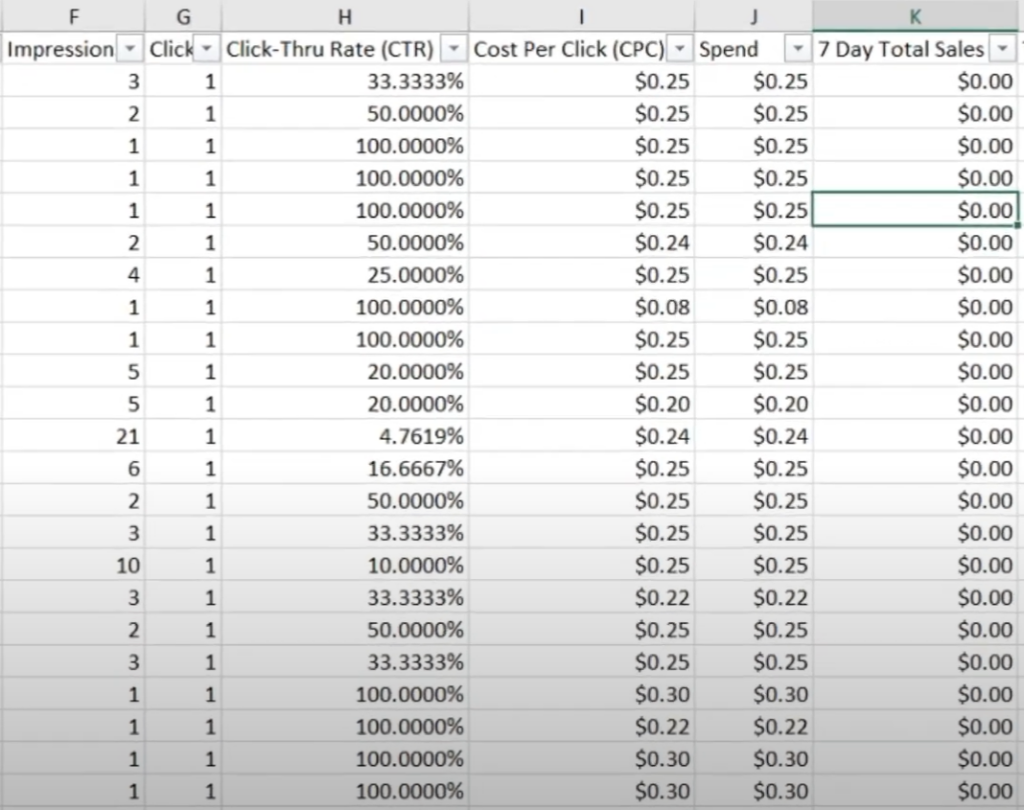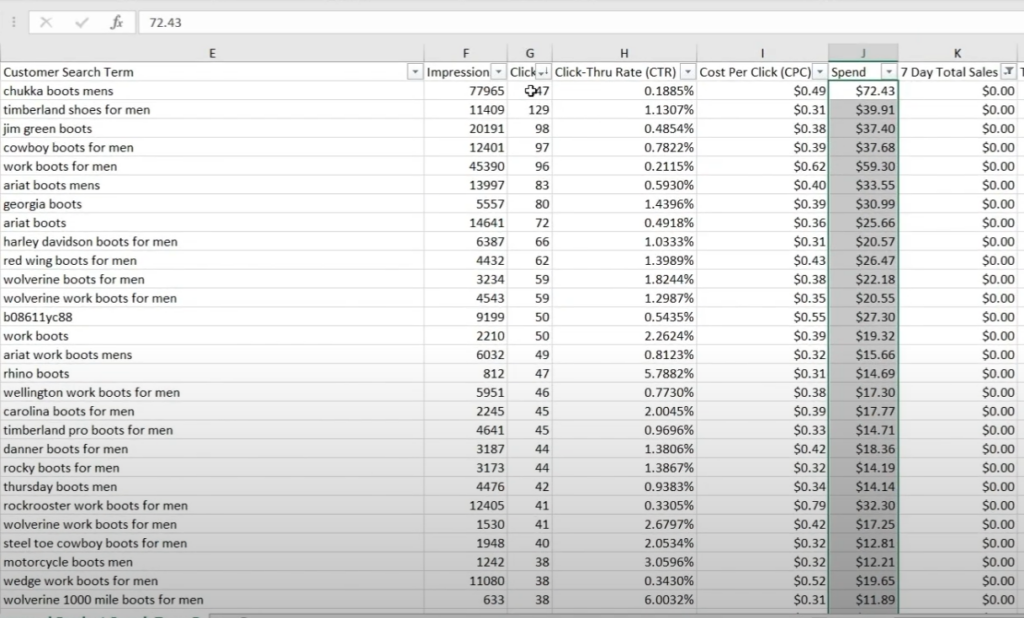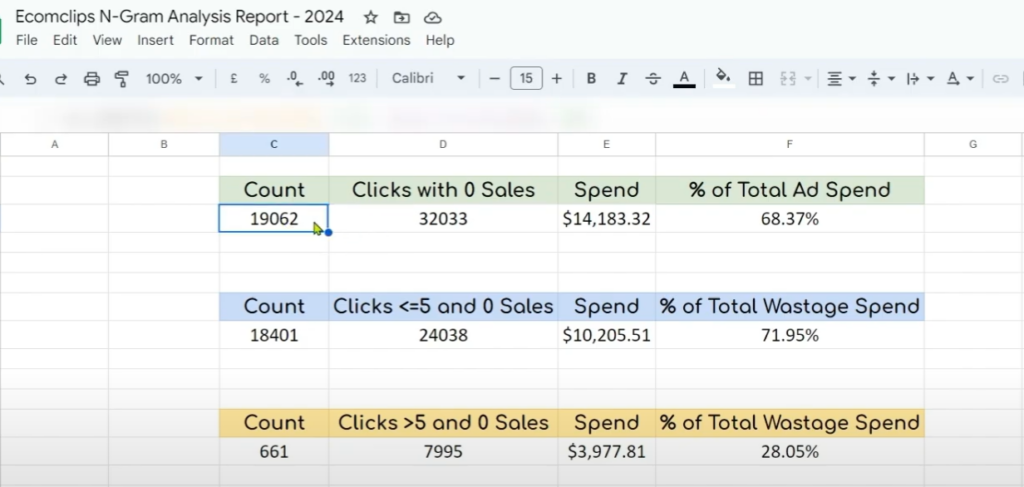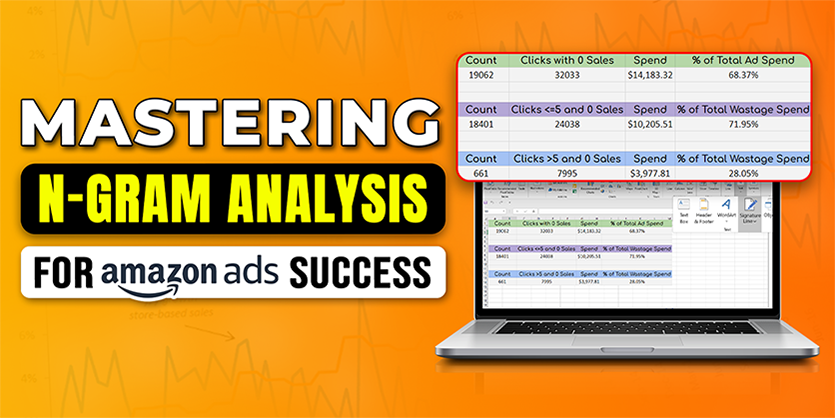For Amazon sellers, running a successful PPC (Pay-Per-Click) campaign requires more than just targeting keywords; you need to understand customer search terms and manage your search term reports effectively. Failing to optimize these can lead to significant wasted spending on irrelevant keywords, ultimately affecting your bottom line. N-gram analysis is a highly effective method for breaking down search queries in Amazon Ads. It works by splitting search terms into sequences of N words, where N represents any specified number of words in the sequence. In this blog, we’ll explore the power of N-gram analysis, an advanced technique that helps you dissect search queries, optimize your Amazon PPC campaigns, and minimize unnecessary ad spend.
1. N-Gram Analysis: Customer Search Terms
Customer search terms are the actual phrases people use when searching for products on Amazon. These terms play a vital role in generating traffic and sales. However, many sellers overlook low-performing search terms, assuming that low clicks equate to low impact. This oversight can lead to wasted thousands of dollars on non-converting search terms.
By analyzing customer search terms, sellers can identify high-performing keywords to optimize their product listings and marketing campaigns. This helps drive more targeted traffic and increase conversions. Additionally, n-gram analysis can uncover long-tail keywords that are less competitive but have high conversion rates, providing a valuable source of traffic. Furthermore, understanding customer intent through n-gram analysis allows sellers to tailor their product offerings and marketing messages to meet specific needs, enhancing customer satisfaction.
That’s why optimizing search terms is crucial for maximizing return on ad spend (ROAS) and reducing wasteful spending.
a) The Importance of Search Term Reports
Amazon provides search term reports that show how customers interact with your PPC ads. These reports reveal which search terms generate clicks, conversions, and sales. Regularly analyzing this data is critical to uncover hidden opportunities and preventing financial losses. Here are some PPC Pro tips for Effectively Analyzing Search Term Reports.

- Regularly Review Data: Analyze your search term reports on a regular basis to stay updated on the performance of your campaigns.
- Use Keyword Research Tools: Combine search term data with keyword research tools to identify additional relevant keywords and phrases.
- Experiment with Different Match Types: Test different match types (broad, phrase, exact) to find the optimal balance between reach and relevance.
- Utilize Negative Keywords: Exclude irrelevant keywords from your campaigns to improve your targeting and reduce wasted spend.
- Track Performance Metrics: Monitor key performance indicators (KPIs) such as click-through rate (CTR), conversion rate, and average order value to measure the effectiveness of your campaigns.
By effectively analyzing your Amazon search term reports, you can gain valuable insights into your customers’ search behavior and optimize your PPC campaigns for maximum success.
b) Generating and Organizing Search Term Reports
To start, access your Amazon Ads dashboard and generate a Search Term Report. This report will provide detailed insights into the search terms triggering your ads, along with key performance metrics such as clicks, impressions, and conversions.
Here, on the report, you’ll receive a spreadsheet with detailed insights into which search terms triggered your ads, along with key performance metrics like:
- Clicks
- Impressions
- Conversions
You can now identify underperforming search terms:
- Filter the report to focus on automatic campaigns.
- Highlight search terms that have high clicks but no sales.
- This is the first step to identifying terms that are draining your ad budget but not delivering conversions.
Once the report is generated, you’ll want to filter and organize the data. Begin by focusing on automatic campaign search terms that received clicks but resulted in no sales. This step helps in identifying the terms that are draining your ad budget without delivering conversions.
2. N-Gram Analysis: Identifying Wasted Spend
Wasted spend often comes from search terms that drive clicks but fail to generate sales. For example, if a search term has received 15+ clicks without a single conversion, it’s a sign that the term is not performing well. These ineffective terms can be added as negative keywords to prevent your ads from appearing for them, ensuring your budget is spent more productively. Here are some tips that you as a seller can use to reduce the PPC Ads waste spend.

- Review Search Term Reports: Regularly analyze your search term reports to identify terms that have received multiple clicks but no conversions.
- Set Thresholds: Establish a threshold for the number of clicks a term can receive before it is considered non-converting. For example, if a term has received 15+ clicks without a conversion, it may be a candidate for negative keyword targeting.
- Consider Conversion Rate: Look at the overall conversion rate for each search term. If a term has a significantly lower conversion rate than your average, it may be underperforming.
- Use Broad Match Modifiers: Employ broad match modifiers to control the scope of your search terms and reduce the likelihood of irrelevant clicks.
- Utilize Negative Keyword Lists: Create comprehensive negative keyword lists to exclude irrelevant terms and improve your targeting.
- Monitor Campaign Performance: Regularly track the performance of your campaigns and make adjustments as needed to optimize your ROI.
- Experiment with Different Bid Strategies: Test different bid strategies (e.g., manual, automatic) to find the most effective approach for your campaigns.
a) Analyzing Automatic Campaigns
Automatic campaigns, while useful for broad visibility and brand discovery, tend to generate a significant amount of irrelevant clicks. To avoid waste, start by filtering for search terms with zero sales but high clicks. This analysis will help you find terms that have consumed substantial amounts of your budget without contributing to your sales goals.
One effective strategy is to filter your search term reports for terms that have received high click volume but have not generated any sales. These terms are likely consuming a significant portion of your budget without contributing to your revenue. By identifying and excluding these terms, you can redirect your ad spend towards more effective search terms.
- Use Negative Keywords: Create comprehensive negative keyword lists to exclude irrelevant terms and improve your targeting.
- Set Bid Adjustments: Adjust your bids for specific keywords or demographics to optimize performance and control costs.
- Monitor Campaign Performance: Regularly review your campaign metrics to identify areas for improvement and make necessary adjustments.
- Consider Manual Campaigns: For more granular control over your targeting and bidding, consider transitioning some of your automatic campaigns to manual campaigns.
By implementing these strategies, you can avoid wasted spend in your automatic campaigns and ensure that your ad budget is being used effectively to achieve your marketing goals.
b) Manual Campaign Analysis
Once you’ve reviewed your automatic campaigns, shift your focus to manual campaigns. Here, the goal is similar: Identify search terms with high clicks but low or no conversions. Additionally, monitor terms with a high Advertising Cost of Sales (ACoS)—these are draining your resources and should also be marked as negative keywords.
The process here is similar but with added emphasis on managing specific keywords you’ve targeted.
Review Search Terms in Manual Campaigns:
- Open your manual campaign data from the same Search Term Report.
- Identify search terms that have high clicks but low or no conversions.
- Search terms with high click counts but few or no sales can indicate they are not resonating with shoppers and may need to be eliminated.
Monitor High ACoS Terms:
- Sort your report by Advertising Cost of Sales (ACoS).
- Look for search terms with an ACoS significantly higher than your target threshold. For instance, if your target ACoS is 20%, focus on any terms exceeding that mark.
- High ACoS terms are draining your resources and are not cost-effective. These should be evaluated and potentially marked as negative keywords.
By carefully analyzing both high-click, low-conversion terms and high ACoS terms, you can refine your manual campaigns to improve efficiency and profitability.
3. Apply N-Gram Analysis To PPC Ads
This is where N-gram analysis becomes an invaluable tool for refining your search term strategy. N-gram analysis involves breaking down search terms into sequences of N words (e.g., single words, two-word phrases, etc.). By analyzing these N-grams, you can identify patterns in the terms that frequently lead to wasted spending or poor conversion rates.

For a search term like “Carolina shoes for men,” an N-gram analysis would split the phrase into components:
- Unigrams (1-word phrases): Carolina, shoes, for, men
- Bigrams (2-word phrases): Carolina shoes, shoes for, for men
- Trigrams (3-word phrases): Carolina shoes for, shoes for men
a) Splitting Search Terms for Better Insights
With N-gram analysis, you can split search terms into their component parts and spot trends. For example, if you sell men’s shoes, but your N-gram analysis shows frequent searches for ‘women’s shoes,’ adding ‘women’ as a negative keyword will help prevent your ads from being triggered by irrelevant searches. This approach saves money and refines your audience targeting.
b) Identifying Common Negative Phrases
Using N-gram analysis, you can easily spot phrases that frequently appear but don’t align with your product. For instance, terms like ‘cheap’ or competitor brand names that consistently perform poorly can be marked as negative keywords.
c) Saving Thousands with Negative Keywords
By using N-gram analysis to identify wasteful terms, you can save significant sums of money. For example, by negating just a few non-converting N-grams, you might save thousands of dollars over the course of a campaign, allowing you to reinvest that budget into high-performing search terms.
d) Key Takeaways from the Video Tutorial
To fully utilize the benefits of N-gram analysis, here are some key points discussed in our accompanying video tutorial:
- Search Term Report Generation: Learn how to generate search term reports.
- Filtering & Organizing Data: Focus on the right data to uncover key insights.
- Analyzing Search Terms by Match Type
- Identifying Wasteful Spend: Spot search terms that aren’t converting and take action.
- Marking Negative Keywords: Use negative keywords to prevent wasted spend.
- N-Gram Breakdown: Break down search terms into smaller components for deeper insights.
- Actionable Insights: Use this information to refine your campaigns.
4. Optimize PPC Ads: Normal Way Vs N-Gram Analysis
When optimizing Amazon PPC ads, the traditional approach focuses on broad keyword targeting and adjusting bids based on overall performance metrics. This method involves monitoring high-click, low-conversion terms and using negative keywords to prevent irrelevant clicks.
In contrast, N-Gram Analysis offers a more granular approach by breaking down search terms into sequences of words (unigrams, bigrams, trigrams, etc.). This detailed analysis helps identify specific patterns and trends, enabling precise targeting and the exclusion of ineffective terms. N-Gram Analysis can uncover hidden inefficiencies and optimize ad spend more effectively by analyzing the components of search terms.
Here’s a comparative table highlighting the key differences between Amazon N-Gram PPC Optimization and Normal PPC Ads Optimization:
| Aspect | Amazon N-Gram PPC Optimization | Normal PPC Ads Optimization |
|---|---|---|
| Approach | Uses N-gram analysis to break down search terms into sequences of N words for in-depth analysis. | Focuses on broad keyword targeting and traditional keyword optimization techniques. |
| Search Term Analysis | Analyzes search terms by splitting them into unigrams, bigrams, trigrams, etc., to identify patterns and trends. | Primarily examines search terms as a whole without detailed breakdowns. |
| Identification of Wasted Spend | Identifies wasteful terms by analyzing patterns and breaking down terms to spot ineffective N-grams. | Identifies wasted spend by examining high-click, low-conversion terms without detailed breakdown. |
| Optimization Techniques | Uses detailed insights from N-gram analysis to fine-tune search term targeting and add negative keywords. | Optimizes based on overall performance metrics, broad match types, and manual adjustments. |
| Keyword Targeting | More precise targeting by identifying specific N-grams that perform poorly or do not convert. | Broader targeting with less emphasis on detailed search term analysis. |
| Negative Keywords | Targets specific negative N-grams to prevent irrelevant searches. | Uses negative keywords based on general performance rather than detailed term analysis. |
| Campaign Performance Improvement | Provides granular insights to improve targeting, reduce wasted spend, and enhance conversion rates. | Improves performance through broad adjustments and monitoring of key metrics. |
| Data Analysis Frequency | Requires regular, detailed analysis of search term reports with N-gram breakdowns. | Involves periodic review of overall search term performance and campaign metrics. |
| Tools and Reports | Uses advanced tools for N-gram analysis and detailed search term reports. | Relies on standard Amazon search term reports and performance metrics. |
| Actionable Insights | Delivers specific, actionable insights by breaking down search terms into smaller components. | Provides actionable insights based on overall keyword performance and general trends. |
This table should help clarify the differences between N-gram-based PPC optimization and traditional PPC optimization approaches.
Conclusion!
Optimizing your Amazon PPC campaigns with N-gram analysis is one of the most effective ways to reduce wasted spend and drive more targeted traffic. By consistently analyzing search term reports, filtering for irrelevant terms, and applying N-gram analysis, you can drastically improve your campaign’s performance and profitability.
If you’re not already utilizing these strategies, now is the time to start. Don’t let wasted ad spend affect your bottom line—implement N-gram analysis today and start optimizing for better results.
Here, at Ecomclips, we have been helping many Amazon sellers boost their sales and capture market share with both PPC and organic SEO. If you need any help boosting your Amazon sales or growing your brand, please don’t hesitate to mail us at our email address, info@ecomclips.com
Also, if you require an Amazon store or account audit for both PPC ads and SEO, you can let us know via our email address, and we will provide you with a free account audit. Additionally, if you require any assistance, please reach out to us in the comment box. We are here to assist you in managing PPC advertisements to improve your profit, so we offer a personalized approach to our service.



